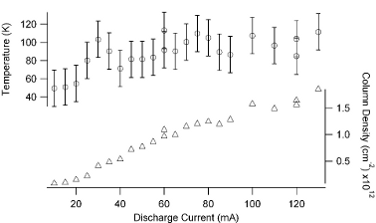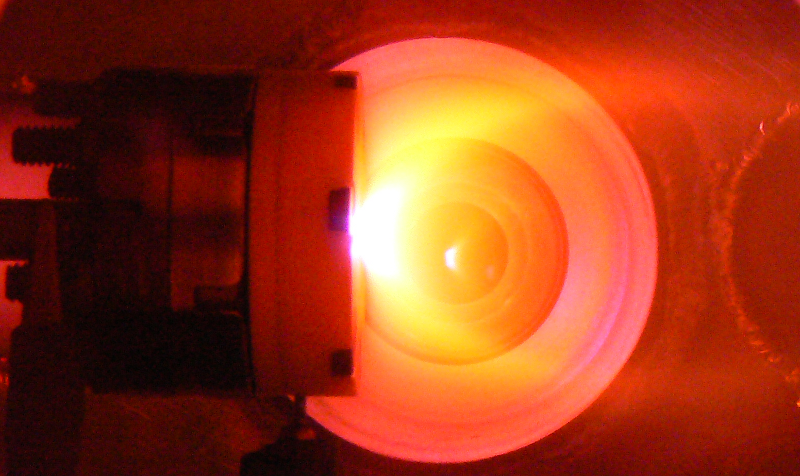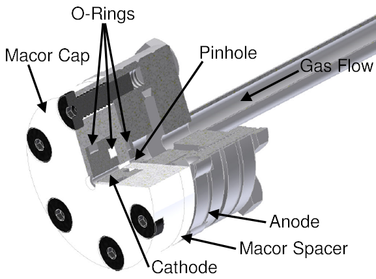Supersonic Expansion Discharge Source
Motivation
As part of our goal to acquire high-resolution spectra of astronomically important molecular ions with the SCRIBES experiment, we require a way to produce ions that are translationally and rotationally cold. However, most commonly-used ionization techniques (e.g. electron impact, fast atom bombardment, electrical dicharge) produce high-temperature ions. The benefits of cold ions are numerous: their spectra are astronomically relevant, simpler and easier to assign; and, owing to their narrow velocity distribution, their spectra have reduced linewidths. For the SCRIBES experiment, we are coupling a continuous DC discharge with a supersonic expansion to obtain cold ions for spectroscopy.
Supersonic Expansions
Supersonic expansions have been used for many years to translationally and rotationally cool gas-phase species. By forcing a gas at high pressure through a small orifice into vacuum, an expansion plume is generated in which the gas molecules are accelerated faster than the local speed of sound, thus creating a supersonic expansion. In this adiabatic process, the heat energy of the gas is converted into directed translational energy, and the temperature of the gas decreases as the velocities of the individual molecules approach the same value. However, because the gas is expanding into a greater volume, the local number density, and consequently the collision rate, decrease rapidly. As a result, full thermodynamic equilibrium is lost throughout the expansion, and the degrees of freedom of the gas (vibration, rotation, and translation) can no longer be represented by a single temperature. Due to energy transfer efficiency considerations, typically in a supersonic expansion Tvib >> Trot ≥ Ttrans. Depending on the details of the gas conditions, typical Trot and Ttrans values range from 0.5 - 30 K.
Molecular ions can be produced under supersonic expansion conditions by seeding a small amount of precursor gas into a larger amount of buffer gas, and striking a DC discharge as the mixture passes through the orifice. Typically, this is done by pulsing a small amount of gas through a valve upsetream of the orifice, thereby producing short pulses of expanding plasma. However, SCRIBES requires a continuous beam of ions, so we must instead utilize a continuous expansion. This creates two unique challenges: maintaining a good vacuum with a high, continuous flow of gas leaking into the chamber, and constructing a supersonic expansion source that can withstand the thermal load generated by the discharge while still producing cold ions. We solve the first challenge by pumping our system with a large Roots blower (pumping speed 3200 L/s at 20 mTorr), and the second by performing tests on a variety of source designs.
Source Design, Testing and Evaluation
The continuous supersonic expansion discharge source that we have designed consists of a stainless steel baseplate with a small pinhole, a macor spacer, a stainless steel electrode, and a macor cap to insulate the electrode from the surrounding vacuum chamber. Gas-tight seals are made between each piece by means of high-temperature silicone o-rings. The baseplate is held at ground potential, and a negative high voltage is applied to the electrode to generate a plasma, which expands through the electrode and into the vacuum chamber. With this design, the source achieves a lifetime of about 200 operating hours.
To measure the temperature distributions of ionic species in the expansion, we have performed cavity ringdown spectroscopy on the ν2 fundamental band of H3+ located at 3.7 μm. (for more information on our group's work with this species, check out the H3+ page). For this spectroscopy, a mid-infrared laser has been constructed by mixing the outputs of a 10 W frequency-doubled Nd:YVO4 laser (532 nm) with a tunable ring dye laser (560-750 nm) in a MgO-doped periodically-poled LiNbO3 crystal. Its 350+ μW of output power can access the entire spectral range from 2.2-4.8 μm.

The DFG cavity ringdown spectrometer.

Temperatures and ion column densities derived from CRDS measurements of H3+ in the continuous supersonic expansion discharge source.
From the ringdown measurements of H3+, we have measured the ions' rotational temperature as well as the total ion column density produced in the source as a function of the discharge current. The observed rotational temperatures predominantly fall in the range of 80-110 K from discharge currents of 25-130 mA, and remain constant over this range. However, the observed column density increases by about an order of magnitude as the current is increased. At the highest currents, we estimate an ion density of 2 x 1012 cm-3. This source functioned for approximately 200 hours.
The ion source in its current form is promising for use with SCRIBES, but its performance can likely be further improved. To do so requires the use of an ion with a smaller rotational constant such that lower rotational temperatures can be reached in the expansion. A suitable candidate for this purpose is HN2+, whose ν1 vibrational band is accesible with our DFG/CRDS system. This is the next project for improving the source design.


